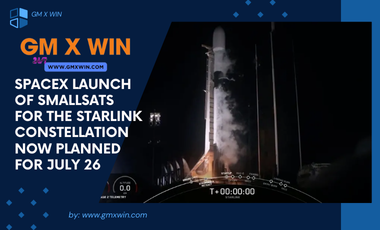The rapid expansion of satellite technology is transforming our world, enabling unprecedented connectivity and data services. Among the leading innovators in this field is SpaceX, Elon Musk’s aerospace company, which is at the forefront of deploying small satellites (smallsats) to build its ambitious Starlink constellation. This constellation aims to provide global broadband internet coverage, especially in remote and underserved areas. The latest chapter in this venture is the planned launch of additional smallsats on July 26, 2024, marking a significant milestone in SpaceX’s ongoing mission. This article explores the details of this launch, the technology behind Starlink, and its broader implications for global connectivity and the satellite industry.
The Evolution of SpaceX
Early Beginnings
Space Exploration Technologies Corp., better known as SpaceX, was founded in 2002 by Elon Musk. From the outset, the company’s mission was to reduce the cost of space travel and make it possible for humans to live on other planets. Early projects included the Falcon 1 rocket, which marked SpaceX’s first foray into space launches.
Major Milestones
SpaceX’s journey has been marked by several key milestones:
- Falcon 1 and Falcon 9 Rockets: The development and successful launches of these rockets, particularly the reusable Falcon 9, have revolutionized space travel economics.
- Dragon Spacecraft: Initially designed to carry cargo to the International Space Station (ISS), the Dragon has also transported astronauts, enhancing human spaceflight capabilities.
- Starship Development: SpaceX’s ambitious project to build a spacecraft capable of carrying humans to Mars and other deep-space destinations.
The Vision of Global Connectivity
In line with its mission to make space more accessible, SpaceX embarked on the Starlink project, aiming to create a network of thousands of small satellites in low Earth orbit (LEO) to provide high-speed internet access across the globe.
The Starlink Project
Concept and Objectives
Starlink’s primary objective is to bridge the digital divide by delivering high-speed internet to areas where traditional broadband services are unavailable or unreliable. The constellation is designed to offer low-latency internet suitable for a wide range of applications, from streaming and gaming to remote work and telemedicine.
Technological Innovations
Starlink’s success hinges on several technological innovations:
- Smallsats: These small satellites are equipped with phased-array antennas and laser communication systems to enable high-speed data transfer.
- Low Earth Orbit (LEO): Placing satellites in LEO reduces latency compared to traditional geostationary satellites, which are much farther from Earth.
- Mass Production: SpaceX’s ability to mass-produce smallsats and launch them in large numbers has significantly reduced costs and accelerated deployment.
Current Status
As of mid-2024, SpaceX has launched over 3,000 Starlink satellites, providing coverage to many parts of the world. The service has garnered millions of users, from rural communities in North America to remote regions in Africa.
The July 26 Launch
Mission Overview
The upcoming launch on July 26, 2024, represents another significant step in expanding the Starlink constellation. This mission, designated as Starlink-XX, will deploy additional smallsats to enhance network capacity and coverage.
Launch Vehicle
The mission will utilize SpaceX’s reliable Falcon 9 rocket, known for its reusability and efficiency. The Falcon 9 will carry a payload of approximately 60 smallsats, each weighing around 260 kilograms.
Launch Site
The launch is scheduled to take place from Cape Canaveral Space Force Station in Florida, a key site for SpaceX’s operations. The site has been the departure point for many successful missions, including crewed flights to the ISS and previous Starlink launches.
Mission Timeline
The mission timeline is as follows:
- Pre-Launch Preparations: Final checks and fueling operations will occur in the hours leading up to the launch.
- Lift-Off: Scheduled for 7:00 AM EDT, the Falcon 9 will ascend into space, reaching an altitude where it will deploy the smallsats.
- Satellite Deployment: Approximately one hour after lift-off, the smallsats will be deployed into their designated orbits, beginning their journey to join the Starlink network.
The Technology Behind Smallsats
Design and Manufacturing
Starlink smallsats are designed for efficiency and performance:
- Compact Size: Each smallsat is relatively small, allowing SpaceX to deploy large numbers in a single launch.
- Phased-Array Antennas: These advanced antennas enable the satellites to communicate with user terminals and each other, facilitating seamless internet service.
- On-Board Propulsion: Equipped with ion thrusters, the smallsats can adjust their orbits and maintain their positions within the constellation.
Launch and Deployment
The deployment process involves a carefully orchestrated sequence:
- Falcon 9 Launch: The rocket carries the smallsats into space, reaching a predetermined altitude.
- Satellite Release: The smallsats are released from the rocket in a coordinated manner to ensure they disperse evenly.
- Orbit Adjustment: Using their on-board thrusters, the smallsats maneuver into their final orbits and begin operations.
Network Operations
Once deployed, the smallsats form a mesh network:
- Inter-Satellite Links: The smallsats communicate with each other using laser links, ensuring data is routed efficiently across the network.
- Ground Stations: Data is transmitted to and from ground stations strategically located around the world, connecting the Starlink network to the global internet.
Implications for Global Connectivity
Bridging the Digital Divide
One of Starlink’s most significant impacts is its potential to bridge the digital divide:
- Remote Areas: Providing high-speed internet to remote and rural areas where traditional infrastructure is lacking.
- Emerging Markets: Enabling connectivity in developing countries, fostering economic growth and development.
- Disaster Response: Offering reliable communication services during natural disasters and emergencies.
Economic Opportunities
Starlink’s global coverage opens up new economic opportunities:
- E-Commerce: Facilitating online business operations in previously underserved regions.
- Telehealth: Expanding access to healthcare services through telemedicine.
- Education: Enhancing educational opportunities with online learning platforms.
Challenges and Criticisms
Despite its benefits, Starlink faces several challenges and criticisms:
- Space Debris: The proliferation of smallsats increases the risk of space debris and collisions.
- Astronomical Interference: Astronomers have raised concerns about the impact of satellite constellations on astronomical observations.
- Regulatory Hurdles: Navigating international regulations and securing licenses in different countries can be complex and time-consuming.
The French Aerospace Industry’s Response
Competitive Landscape
The expansion of SpaceX and its Starlink project has prompted responses from other aerospace players, particularly in Europe:
- French Aerospace Companies: Leading firms like Airbus and Thales Alenia Space are developing their own satellite constellations to compete with Starlink.
- Government Initiatives: The French government is supporting initiatives to bolster the country’s aerospace capabilities and maintain competitiveness.
Strategic Partnerships
French companies are forging strategic partnerships to enhance their offerings:
- Collaborations with Telecom Providers: Partnering with global telecom companies to integrate satellite services with existing networks.
- International Alliances: Forming alliances with other aerospace firms to share technology and expertise.
Innovation and R&D
Investment in research and development is crucial for maintaining competitiveness:
- Advanced Satellite Technologies: Developing next-generation smallsats with improved performance and capabilities.
- Reusable Launch Vehicles: Exploring reusable rocket technologies to reduce launch costs and enhance sustainability.
The Future of Smallsat Constellations
Market Growth
The market for smallsat constellations is poised for significant growth:
- Increased Demand: Growing demand for high-speed internet and data services is driving the expansion of satellite constellations.
- Diversification of Applications: Smallsats are being used for a wide range of applications, including Earth observation, climate monitoring, and IoT connectivity.
Technological Advancements
Continued advancements in technology will shape the future of smallsat constellations:
- Miniaturization: Ongoing miniaturization of components will enable the deployment of even smaller and more capable satellites.
- AI and Machine Learning: Incorporating AI and machine learning to optimize satellite operations and data processing.
- Green Technologies: Developing environmentally friendly technologies to mitigate the impact of space debris and enhance sustainability.
Regulatory and Policy Frameworks
Effective regulatory and policy frameworks are essential for the sustainable growth of smallsat constellations:
- International Cooperation: Fostering international cooperation to address challenges related to space traffic management and debris mitigation.
- Spectrum Allocation: Ensuring fair and efficient allocation of radio frequencies to avoid interference and maximize the use of available spectrum.
- Environmental Regulations: Implementing regulations to minimize the environmental impact of satellite launches and operations.
Conclusion
The planned launch of additional smallsats for the Starlink constellation on July 26, 2024, represents a significant milestone in SpaceX’s mission to provide global broadband internet coverage. This launch underscores the transformative potential of satellite technology in bridging the digital divide and creating new economic opportunities. As the aerospace industry continues to evolve, competition and innovation will drive further advancements in satellite technology and connectivity. The future of global connectivity is being shaped by the pioneering efforts of companies like SpaceX, and the journey has only just begun.



